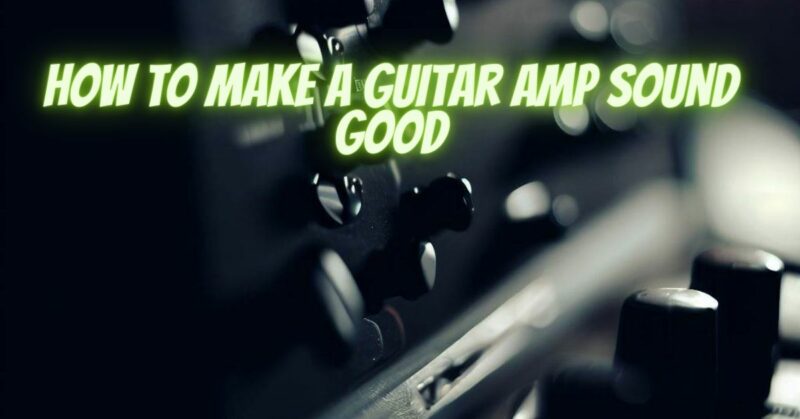A guitar amplifier serves as the sonic canvas for your electric guitar, shaping and enhancing its tone to create a captivating sound. Whether you’re a seasoned guitarist or a novice player, unlocking the full potential of your guitar amp can elevate your playing experience to new heights. Here are some tips and techniques to help you make your guitar amp sound good and unleash its sonic possibilities.
1. Understand Your Amp’s Controls
Before diving into tone shaping, familiarize yourself with your amp’s controls and how they affect your sound. Most guitar amps feature common controls such as:
- Gain: Adjusts the amount of distortion or overdrive in your signal.
- Volume: Sets the overall output level of the amp.
- Treble, Middle, and Bass: Equalization controls to shape the tonal balance.
- Reverb: Adds ambience and depth to your sound.
- Presence: Adjusts the high-frequency response and clarity.
- Master Volume: Controls the overall output level after the preamp stages.
Experiment with each control to understand its impact on your tone and how it interacts with different guitar pickups and playing styles.
2. Start with a Clean Slate
Begin with all tone controls set to neutral or midway positions and the gain set low to achieve a clean, uncolored sound. From this neutral starting point, gradually adjust the controls to tailor your tone to your liking. Resist the temptation to crank up the gain and volume right away—start with modest settings and gradually increase them as needed to avoid overwhelming distortion.
3. Experiment with EQ Settings
The treble, middle, and bass controls on your amp allow you to sculpt the frequency response to suit your preferences. Here are some general guidelines for EQ adjustment:
- Treble: Boosting the treble can add sparkle and definition to your sound, while cutting it can reduce harshness and brighten overly aggressive tones.
- Middle: Adjusting the middle control affects the midrange frequencies, which are crucial for defining the character and presence of your sound. Experiment with different middle settings to find the sweet spot for your playing style.
- Bass: Increasing the bass can add warmth and depth to your tone, while reducing it can tighten up the low end and prevent muddiness.
4. Mind the Gain
The gain control on your amp determines how much distortion or overdrive is added to your signal. Experiment with different gain settings to achieve the desired level of crunch or saturation:
- Low Gain: Lower gain settings produce cleaner tones with minimal distortion, suitable for genres like jazz, blues, and clean pop.
- Medium Gain: Moderate gain settings provide a balanced blend of clean and overdriven tones, suitable for classic rock, indie, and alternative styles.
- High Gain: Higher gain settings deliver aggressive distortion and sustain, ideal for hard rock, metal, and heavy genres.
5. Explore Built-in Effects
Many guitar amps come equipped with built-in effects such as reverb, delay, chorus, and tremolo. Experiment with these effects to add depth, dimension, and ambience to your sound. Start with subtle settings and adjust the intensity to complement your playing style and musical genre.
6. Consider External Effects
In addition to built-in effects, you can further enhance your amp’s sound by incorporating external effects pedals or multi-effects units. Experiment with distortion, modulation, and time-based effects to expand your sonic palette and create signature sounds unique to your playing style.
7. Embrace Tube Warmth
If you own a tube amplifier, embrace the natural warmth, richness, and responsiveness of tube-driven tone. Tube amps respond dynamically to your playing dynamics, producing lush harmonics and smooth saturation. Experiment with tube-driven overdrive and distortion to achieve classic vintage tones with organic warmth and character.
8. Mind Your Environment
Consider the acoustics of your playing environment when dialing in your amp settings. If you’re playing in a small room with reflective surfaces, you may need to reduce the reverb and adjust the EQ to compensate for the room’s natural resonance. Conversely, in a larger space with more absorbent surfaces, you may want to increase the reverb and adjust the EQ to add presence and clarity to your sound.
Making your guitar amp sound good is a journey of exploration, experimentation, and self-discovery. By understanding your amp’s controls, starting with a clean slate, experimenting with EQ settings, and embracing the unique characteristics of your amp’s tone, you can unlock its full sonic potential and create inspiring sounds that elevate your playing to new heights. Whether you’re seeking classic vintage tones, modern high-gain aggression, or anything in between, the key is to trust your ears, follow your instincts, and let your creativity soar.

